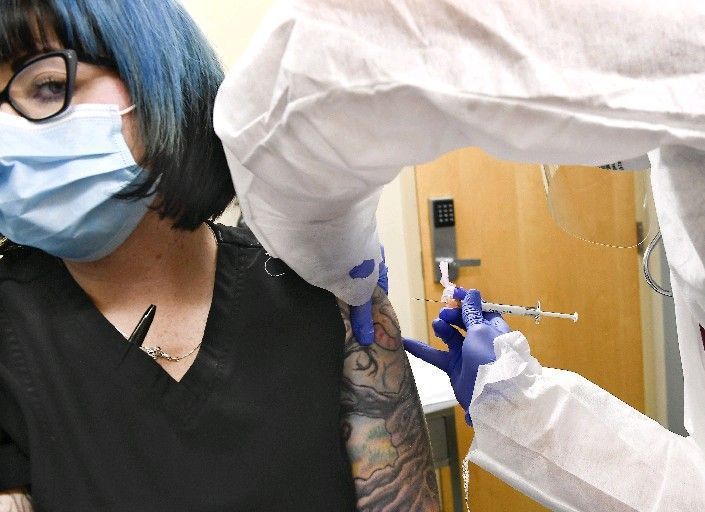The state government is looking to complete the first round of vaccinations of critical health care workers, nursing home residents and emergency medical responders in late January or early February.
All but one of the vaccines in clinical trials in the United States will require two doses. The Governor’s COVID-19 Advisory Group is anticipating 380,000 members of this first group will have received their first dose in January, and more than 210,000 will have been vaccinated a second time by that time.
State planners estimated 204,000 health care workers, 22,000 nursing home residents, and 6,000 medical first responders will be vaccinated in this initial phase.
Not all health care workers and emergency medical personnel will want to get vaccinated. The state estimates assumed a refusal rate of 20%. Using that projection, 51,000 health care workers and 7,500 emergency medical workers will opt not to be inoculated.
The next groups to be vaccinated on the recommended distribution schedule are other essential workers, people over age 65, and individuals under age 65 at high risk for severe COVID-19 illness due to underlying medical condition.
Also, vaccinations will be given in congregate settings other than nursing homes, such as state prisons where nine inmates have died and nearly 1,800 have been infected.
The second phase is expected to take from mid-January to late May to complete.
Vaccinations of healthy people over age 18 and youths under 18 are slated to start in early June, and it is expected that this third phase will take two or three months to complete.
HOW MANY DOSES CAN WE EXPECT?
Once the U.S. Food and Drug Administration grants its approval, Pfizer Inc. and German partner BioNTech are expected to distribute 6.4 million doses of their vaccine in an initial allotment. Based on state population, Connecticut should receive 64,000 doses in their first round.
States are being required to submit weekly orders. The governor’s office said an initial order of 31,200 doses was submitted Friday to the federal Centers for Disease Control and Prevention.
The federal government is overseeing a centralized system to order, distribute, and track COVID-19 vaccines through the CDC. Vaccines will come through a CDC centralized distributor or directly from a manufacturer.
State officials have been anticipating that the first 31,200 doses of the Pfizer-BioNTech vaccine will be delivered on Dec. 14 based on federal representations.
The delivery of the first 63,000 doses of the vaccine from Moderna Inc. is expected on Dec. 21.
The initial distribution schedule anticipates 592,000 doses will be administered from mid-December through January.
By the end of January, it is anticipated 380,000 initial doses will be given out in this first round of vaccinations, and 212,000 members of this high priority group will have received their second shot.
After Dec. 14, the state schedule assumes weekly distributions of 94,000 doses the week of Dec. 21, 51,000 doses the week of Dec. 28, 82,000 doses the week of Jan. 11, 145,000 doses the week of Jan. 18, and 107,000 doses the week of Jan. 25.
HOW MUCH WILL THIS COST CONNECTICUT?
State officials do not have a cost estimate at this time, but Gov. Ned Lamont has repeatedly stated that administrative costs will be steep.
The federal government is purchasing vaccine doses and paying for the distribution.
It is not yet clear how, and by whom, the shots will be distributed here.
Vaccines will be given to the American people at no cost, but vaccination providers will be able to charge an administration fee for giving the shot to someone.
The CDC said public or private health insurance will reimburse vaccine providers for this fee. A federal coronavirus relief fund will pay for any uninsured patients.
In Connecticut, 52% of the state’s population have employer-provided insurance, nearly 36% are insured through Medicaid or Medicare, and almost 5% have individual coverage, according to a Kaiser Family Foundation analysis. An estimated 6% of state residents were uninsured.
The Lamont administration is looking to the federal government to cover any costs to the state, but Congress has been deadlocked on COVID-19 relief, including funding to distribute vaccines.
There was growing optimism last week about a breakthrough in the impasse. A bipartisan group of centrist lawmakers proposed a $908 billion compromise package that received widespread attention.
The bipartisan plan included $16 billion for vaccine development and distribution, as well as testing and contact tracing. If distributed based on state population, Connecticut would receive $160 million of that funding.
Lamont has raised the possibility of using the state’s $3 billion budget reserve fund if no federal funding for vaccine distribution.
It remains uncertain how this would be done.
It is unclear if Lamont will be able to use his emergency powers to appropriate reserve funds for vaccine distribution. If not, the legislature’s approval may be needed to revise a state law that says the reserve funds can only be used to retire deficits and unfunded pension liabilities.
A third possibility is the state pays for its unbudgeted distribution costs out of the operating budget. State law authorizes automatic transfers from the budget reserve fund to offset any year-end deficit.
The Lamont administration proposed to chiefly rely on this mechanism when state law required the governor present a plan for closing a projected $2 billion deficit in early October. According to the latest estimates, the current fiscal year is now expected end next June 30 in a $879.4 million shortfall.





